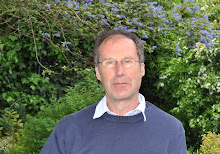
To the Strand Gallery in London where Dave Brown, who joined us on the last leg of our ambulance trip earlier this year, has an exhibition of photographs of famous comedians entitled Tough Crowd. A monochromed Bill Bailey looks tormented, Julia Davis (above) appears concerned, Chris Addison peers dreamily from behind red scaffolding, Tim Minchin resembles Jesus pondering his crucifixion, Alice Lowe’s mascara streaks down her tear-stained face. These intimate photographic portraits of comedians as you never see them are a selection from more than 50 taken over the past three months. They all have one aspect in common – there is not a hint of a smile.
“I wanted to show how difficult it is to be in the comedy business,”says Dave. “I wanted to show how hard it is to make people laugh, how hard it is to get a break and how hard it is to stay there. Tough Crowd isn’t just about the audience, it also says how tough it is to be a comedian, how thick-skinned you need to be.”To achieve his idea, he asked the comedians he photographed to recall the lowest moments in their career. It might have been after receiving a scathing review or a night when no one laughed or an audience was rude or hostile. It may have been when a script they had submitted was rubbished and thrown back in their face.
“Comedians are often fragile, sensitive characters at odds with their public face,” continues Dave. “In the early days of trying to make a success of it, you’re travelling around the country on your own ending up in a pub in the middle of nowhere that pretends to be a comedy club but which only has an upturned crate for you to perform on, and then you lay your soul on the line with sensitive material and you’re lucky if four people are listening to you.”Dave is speaking from experience. He’s been around comedians for 20 years, most notably with The Mighty Boosh together with Noel Fielding and Julian Barrett. He played Bollo the monkey, but as a graphic designer by trade, he created much of the group’s visual identity. He now designs books and DVDs for other comedians including Jimmy Carr and Tim Key. Photography is a sideline passion. He has known Fielding since they were students together at Brunel University and would lend him moral support when he first started gigging. When he joined the Boosh full-time they would enjoy sell-out shows at the O2 Arena but not before the slog of small venues with only three grannies to play to. Dave also knows only too well the truism that what makes a comedian’s job even more exacting is that you may have an audience rolling in the aisles one night and yet the same material dies on you the next. Sara Pascoe (below), another of Brown’s subjects, uses a restaurant analogy.
“When a waiter drops a tray of crockery some people cheer, others ignore it, some are even angry. There are so many factors that can shape the mood of an audience.”

So how did the subjects themselves feel about being photographed in this contradictory way? Jessica Forteskew, who Dave has captured looking decidedly world-weary, sums up the general feeling.
“It was amazing to be asked to do a shot when you didn’t have to go ‘Hey, look at me, I’m hilarious.’”Limited edition prints from all the photographs on show can be bought from £50 - £100 depending on the size. The money will go to the charity Afrikids that runs projects helping children in the poverty-stricken area of the north of Ghana where Dave has visited and photographed. The exhibition at the Strand Gallery, London WC2, runs until 16 December.






